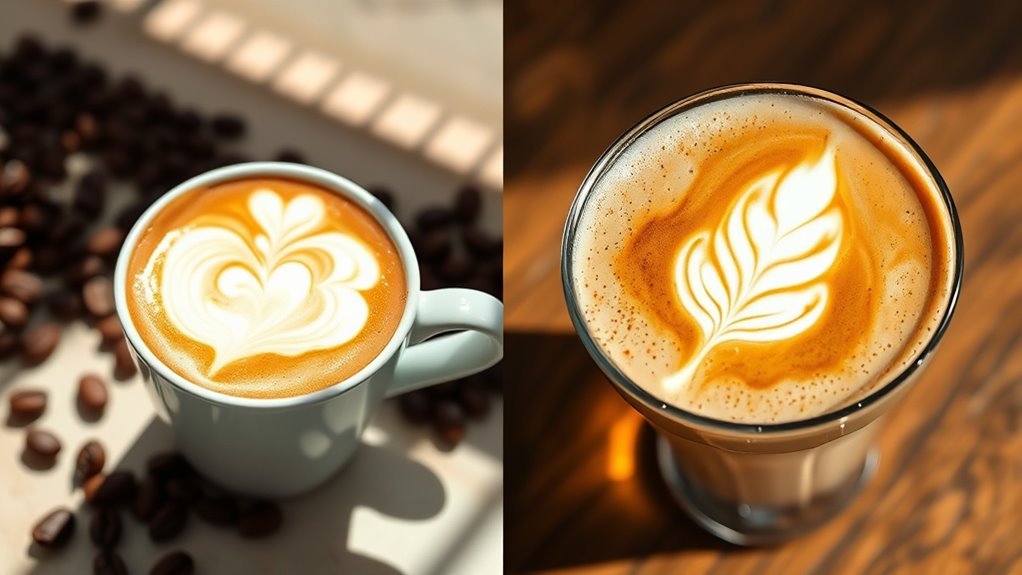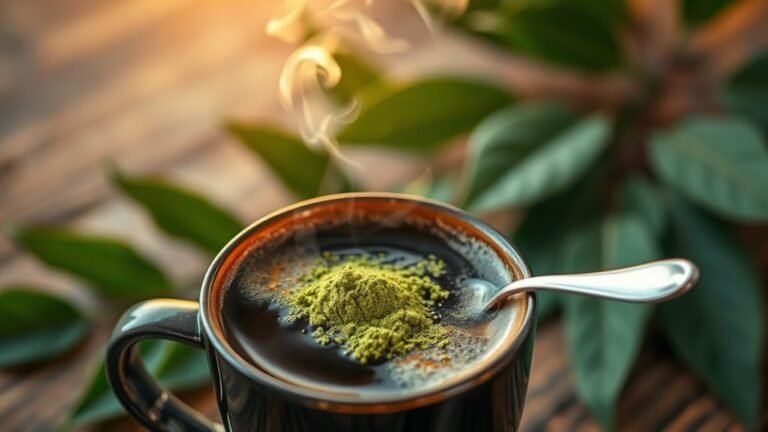How to Make a Flat White vs. a Latte
To make a flat white, pull a double espresso shot and steam milk to 55–65°C, creating smooth microfoam with minimal air for a velvety texture. Pour steadily at a higher angle into a smaller cup. For a latte, use a darker roast espresso, steam milk to 60–70°C with more foam, and pour gently to form a creamy, frothy top in a larger cup. Mastering these steps sharpens your barista skills—discover the nuances behind each element next.
Understanding the Origins of Flat White and Latte

Coffee culture has evolved considerably over the years, and understanding the origins of the flat white and latte will help you appreciate their differences. You’ll see that both drinks reflect distinct cultural significance tied to their places of origin. The flat white emerged in Australia and New Zealand during the 1980s, symbolizing a shift towards a more refined espresso experience with microfoam milk. Meanwhile, the latte, rooted in Italian tradition, gained popularity internationally as a creamy, milk-forward beverage. Recognizing this historical evolution allows you to grasp why the flat white focuses on balance and texture, while the latte emphasizes milk’s sweetness and volume. By knowing their backgrounds, you’ll better understand how these drinks fit into the broader coffee landscape and how their unique characteristics serve different tastes.
Key Ingredients for Both Drinks
Both the flat white and the latte rely on a few essential components that define their distinct profiles. The key ingredients for both drinks are espresso and steamed milk, but the proportions and texture set them apart. You’ll need freshly pulled espresso shots as the base, providing a rich, concentrated flavor. Then, steamed milk is added—its texture and volume determine whether you get a creamy flat white or a frothy latte. To achieve this, vital tools include a quality espresso machine with a steam wand and a milk frothing pitcher. Mastering these tools lets you control the milk’s microfoam, vital for that smooth flat white crema or the airy latte foam. Knowing these basics frees you to craft each drink perfectly.
Choosing the Right Coffee Beans
Now that you understand the importance of espresso and steamed milk, selecting the right coffee beans becomes your next focus. Coffee bean selection directly influences the flavor and texture of both flat whites and lattes. You’ll want to evaluate roast profiles carefully: lighter roasts offer bright, acidic notes, while medium to dark roasts provide richer, bolder flavors that stand up well to milk. For a flat white, a medium roast with balanced acidity and sweetness often works best, giving you clarity in taste without overpowering the milk. In contrast, a latte can handle a darker roast, offering deeper, chocolatey undertones. Always choose freshly roasted beans, grind them just before brewing, and experiment within these roast profiles to find your ideal cup.
Espresso Shot Preparation Techniques

To pull the perfect espresso shot, you’ll need to grind your coffee beans to the right fineness and tamp them evenly for consistent extraction. Pay close attention to tamping pressure to avoid channeling and guarantee even water flow. Controlling your extraction time is essential — aim for about 25 to 30 seconds to balance flavor without bitterness or sourness.
Grinding Coffee Beans
Grinding coffee beans is an essential step in pulling the perfect espresso shot for both a flat white and a latte. You need to focus on selecting the right coffee grind sizes to control flavor extraction effectively. A grind that’s too coarse will under-extract, resulting in weak, sour notes, while a grind too fine risks over-extraction, producing bitterness. Adjust your grinder to achieve a fine, consistent texture suited for espresso machines, ensuring balanced flavor extraction that highlights the coffee’s richness. Remember, even slight variations in grind size can alter the shot’s taste and body. Take time to calibrate your grinder based on your beans and machine, giving you the freedom to craft espresso shots that perfectly complement your flat white or latte.
Tamping for Consistency
Once you’ve dialed in your grind size, the next step is tamping—applying even pressure to the coffee grounds in the portafilter. Mastering tamping pressure is essential to achieve a consistent density, which guarantees uniform extraction and a balanced flavor. Here’s how to do it:
- Distribute grounds evenly before tamping to avoid channeling.
- Apply firm, steady pressure—around 30 pounds—to compress the grounds uniformly.
- Keep your tamper level; tilting causes uneven density and extraction.
- Polish the surface with a slight twist to smooth the puck, sealing the grounds tightly.
Extraction Time Control
Extraction time is a critical factor in pulling the perfect espresso shot, directly influencing flavor balance and intensity. You need to monitor and adjust extraction time carefully to match your brewing methods, ensuring neither under-extraction (sour, weak) nor over-extraction (bitter, harsh). Typically, espresso shots range between 25-30 seconds, but variations depend on grind size, dose, and machine pressure. Use a timer and observe results to refine your technique.
| Extraction Time | Flavor Profile |
|---|---|
| < 25 seconds | Sour, under-extracted |
| 25-30 seconds | Balanced, ideal |
| > 30 seconds | Bitter, over-extracted |
Control extraction time precisely for consistent shots, giving you the freedom to craft either a flat white or latte with your preferred flavor nuances.
Milk Types and Their Impact on Flavor
Although espresso forms the base of both a flat white and a latte, the choice of milk greatly influences their final flavor and texture. Different milk varieties bring distinct flavor nuances that can either amplify or soften the espresso’s intensity. When selecting milk, consider these key aspects:
- Whole milk adds creaminess and sweetness, enriching the espresso’s boldness.
- Skim milk offers a lighter texture but can feel less indulgent.
- Oat milk introduces a subtle nuttiness and smooth body, perfect for dairy-free freedom.
- Almond milk delivers a delicate, slightly sweet flavor that complements rather than overpowers.
Choosing the right milk lets you customize your coffee experience, balancing richness and subtlety to match your personal taste and lifestyle.
Frothing Milk: Flat White vs. Latte
When you’re frothing milk for a flat white versus a latte, the technique and texture you aim for differ considerably. For a flat white, you want microfoam—velvety, dense milk with tiny bubbles—achieved by carefully controlling frothing techniques to incorporate minimal air. Keep the milk temperature between 55–65°C (131–149°F) to preserve sweetness without scalding. In contrast, a latte requires more foam volume, so you introduce more air during frothing, creating a lighter, creamier texture. Here, the milk temperature typically ranges around 60–70°C (140–158°F), allowing for a warmer, frothier milk layer. Mastering these subtle differences in frothing techniques and milk temperature helps you craft each drink’s distinctive mouthfeel, giving you freedom to tailor your coffee experience precisely.
Achieving the Perfect Milk Texture

To achieve the perfect milk texture, you need to master the difference between microfoam and foam density. You’ll want to use specific steaming techniques to create a silky, smooth consistency without large bubbles. Balancing temperature and texture is key to complementing either a flat white or a latte.
Microfoam vs. Foam Density
Microfoam and foam density play an essential role in defining the texture and mouthfeel of your coffee. Understanding microfoam characteristics helps you craft a smooth, velvety layer with fine bubbles that enhance foam stability, avoiding large, airy pockets. Here’s what you need to focus on:
- Microfoam should be silky, with tiny, uniform bubbles for a creamy texture.
- Foam density varies: flat whites demand a thinner, denser microfoam, while lattes allow thicker, lighter foam.
- Stable foam maintains texture without separating or collapsing quickly.
- Achieving the right balance lets you express freedom in coffee art and flavor, creating a satisfying sip every time.
Master these details, and you’ll elevate your flat white and latte beyond just drinks to sensory experiences.
Steaming Techniques Explained
Although steaming milk may seem straightforward, mastering the technique is essential for achieving the perfect texture that distinguishes a flat white from a latte. Start by positioning the steam wand just below the milk surface to introduce air, creating fine microfoam without large bubbles. Once you hear a gentle hissing, lower the pitcher to fully submerge the wand and heat the milk evenly. Pay close attention to milk temperature; aim between 55°C and 65°C to avoid scalding, which ruins sweetness and texture. Use wrist motion to whirlpool the milk, integrating foam smoothly. These steaming techniques give you control over milk’s consistency, enabling you to craft that velvety flat white or creamier latte. Perfecting this skill frees you to express your coffee style confidently.
Temperature and Texture Balance
When you balance temperature and texture correctly, you reveal the key to silky, smooth milk that complements your espresso perfectly. Achieving texture harmony while maintaining the ideal temperature contrast is essential for both flat whites and lattes. Here’s how you do it:
- Heat milk to around 140-150°F to preserve sweetness without scalding.
- Introduce air gently at the start, then submerge the steam wand to create a velvety microfoam.
- Monitor temperature closely—too hot breaks texture harmony; too cool loses richness.
- Pour immediately to lock in both temperature contrast and silky texture.
Pouring Techniques for Flat White and Latte
Since pouring is the final step that defines the texture and appearance of your coffee, mastering the techniques for flat white and latte is essential. Start by controlling your pouring angles: for a flat white, tilt the cup slightly and pour steadily at a higher angle to integrate the microfoam smoothly, creating a velvety surface without large bubbles. For a latte, lower the pouring angle as you approach the cup, allowing the foam to rise and form a creamy layer on top. To craft latte art, focus on steady, controlled movements and adjust your pour height and speed to shape patterns like hearts or rosettas. Practicing these pouring angles and techniques grants you freedom to personalize your coffee’s look while ensuring the ideal texture for each drink.
Flavor Profiles and Taste Differences
When tasting a flat white versus a latte, you’ll notice the milk texture plays a key role—the flat white uses microfoam for a velvety mouthfeel, while the latte has creamier, frothier milk. You’ll also find the espresso intensity is stronger in a flat white due to the smaller milk volume. Finally, the latte tends to be sweeter and creamier, balancing the espresso with its larger milk content.
Milk Texture Contrast
A key difference between a flat white and a latte lies in the milk texture, which greatly influences their flavor profiles and taste. Understanding these milk texture contrast differences lets you craft coffee that truly suits your mood and freedom to experiment.
- Flat white milk texture is velvety microfoam, creating a smooth, rich mouthfeel that intensifies espresso flavor.
- Latte milk is creamier with thicker foam, softening espresso’s boldness for a milder, sweeter experience.
- The flat white’s thinner milk layer balances espresso with subtle sweetness, appealing to those who crave clarity.
- Latte’s frothier top adds volume and lightness, perfect when you want a comforting, airy sip.
Mastering these textures empowers you to tailor your coffee moments exactly how you like.
Espresso Intensity Levels
Although both flat whites and lattes start with espresso, their intensity levels differ greatly, shaping their unique flavor profiles. When you consider espresso strength comparison, a flat white typically features a more concentrated shot, allowing the espresso flavor notes—like rich caramel, subtle fruitiness, or dark chocolate—to stand out clearly. In contrast, a latte uses the same espresso base but with more milk, softening those bold notes and creating a gentler taste. Understanding these distinctions helps you appreciate how espresso intensity influences your experience. If you want a coffee that celebrates the espresso’s depth and complexity, go for a flat white. But if you prefer a milder, creamier drink where espresso is present but less dominant, a latte suits you better. This espresso strength comparison guides your choice with clarity.
Sweetness and Creaminess
Since milk plays an essential role in shaping the sweetness and creaminess of your coffee, understanding its texture and temperature is key to distinguishing a flat white from a latte. The sweetness levels and creaminess factors differ significantly between the two, influencing your overall experience. Here’s what to focus on:
- Flat whites use microfoam—velvety, fine milk bubbles that enhance natural sweetness without overwhelming creaminess.
- Lattes have thicker, frothier milk, boosting creaminess factors and softening espresso’s edge.
- Temperature matters: hotter milk heightens perceived sweetness but can mute delicate espresso notes.
- The balance you prefer—more sweetness or more creaminess—guides your choice between these drinks.
Master these elements, and you’ll savor coffee exactly how you want it—free, flavorful, and fulfilling.
Tips for Brewing at Home

Where should you begin when brewing a flat white or latte at home? Start by selecting quality coffee equipment tailored to your needs—an espresso machine with a reliable steam wand is essential. Invest in a good grinder to guarantee freshly ground beans, as grind size directly affects extraction. Use filtered water heated to about 195–205°F for ideal flavor. Mastering milk steaming is key: aim for silky microfoam without large bubbles to create that signature texture. For a flat white, keep milk velvety and less frothy; for a latte, allow a bit more foam for creaminess. Measure your coffee dose precisely, typically 18–20 grams for a double shot. Remember, home brewing is about control—adjust variables to suit your taste and enjoy freedom in crafting your perfect cup.
Frequently Asked Questions
Can I Use Non-Dairy Milk for a Flat White or Latte?
You can absolutely use non dairy options for your flat white or latte. Just keep in mind that milk frothing varies with different plant-based milks—oat and almond milk froth well, while others like coconut might be less stable. To get a creamy texture, choose barista blends designed for frothing. Experiment a bit, and you’ll enjoy a delicious, dairy-free coffee that suits your taste and lifestyle perfectly.
What’S the Best Time of Day to Enjoy a Flat White?
When it comes to enjoying a flat white, the early bird definitely catches the worm. It’s perfect for your morning rituals, giving you that smooth, rich caffeine boost to start your day right. But don’t box yourself in—many find it equally effective as an afternoon pick me up, helping you power through the slump. Ultimately, it’s your call; choose the time that fuels your freedom and keeps you energized.
How Do Caffeine Levels Compare Between Flat White and Latte?
You’ll find that the caffeine content in both drinks largely depends on the espresso shots used. Typically, a flat white has two shots, giving it a stronger beverage strength and higher caffeine content than a latte, which often has just one shot. So, if you want more caffeine and a bolder flavor, go for a flat white. If you prefer a milder, creamier experience, a latte’s your choice.
Are Flat Whites and Lattes Gluten-Free?
Yes, both flat whites and lattes are typically gluten-free since they’re made with espresso and milk—gluten-free ingredients by nature. However, if you have coffee allergies or sensitivities, it’s wise to check with your barista about any added flavorings or cross-contamination risks. When you’re aiming for freedom from gluten, always confirm ingredients and preparation methods to guarantee your drink is safe and enjoyable.
Can I Make Iced Versions of Flat White and Latte at Home?
You can definitely make iced versions of flat whites and lattes at home. Start with a strong base like cold brew or iced coffee to avoid dilution. For an iced flat white, use cold milk with microfoam, while for an iced latte, just add more milk and ice. Keep your espresso shots fresh and pour over the cold milk and ice. This way, you enjoy café-quality iced drinks with freedom and ease.






